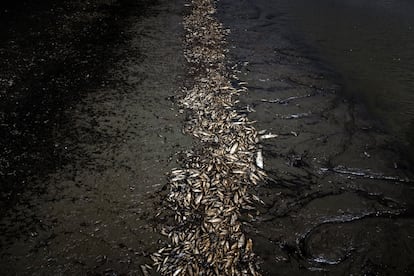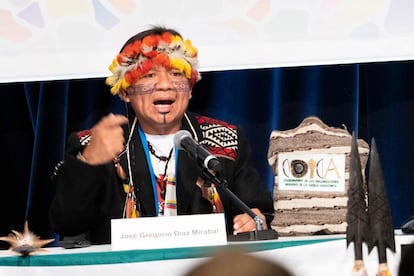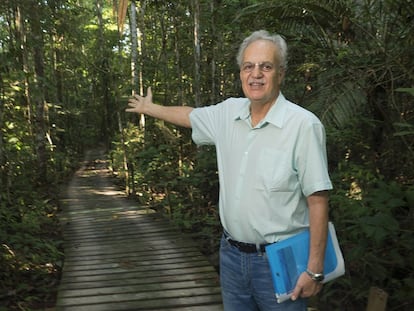Gregorio Mirabal: ‘What’s happening in the Amazon is a climate pandemic’
The indigenous leader and environmental activist cautions that Brazil’s drought is indicative of a larger problem that needs more attention and funding


The vivid images of the crisis unfolding in the Amazon have left an indelible mark on many. The ongoing drought has not only isolated communities in Brazil by severing their river connections, but it has also killed fish populations and iconic pink dolphins. While multiple factors have contributed to the alarming situation, Gregorio Mirabal, a Venezuelan from the Kurripako indigenous people, calls it a “climate pandemic.” He attributes this crisis to “a combination of mercury pollution, deforestation, drought and climate change.”
Mirabal is a member of the Science Panel for the Amazon (SPA) and the Confederation of Indigenous Organizations of the Amazon Basin (COICA). To prevent adverse impacts, Mirabal says it’s crucial for indigenous people to be recognized so they can claim their ancestral lands. He believes they have proven to be the most capable stewards of the Amazon Basin. Mirabal also notes that the region’s climate has become increasingly unpredictable, and that Brazil’s drought is indicative of a larger problem.

Question. We’ve heard alarming news about the situation in Lake Tefé [Brazil] and the unfortunate loss of dolphins. What is the current state of the Amazon region overall?
Answer. The El Niño phenomenon, climate crisis and Covid-19 pandemic have deeply affected the Amazon. Deforestation, fires and mining have led to a severe degradation of this vital ecosystem. In fact, we are now facing a new pandemic – the climate crisis – which has reached a point of no return. The situation in Brazil, which has most of the Amazon, is particularly dire. However, we must remember that the entire region is interconnected, and the issues of drought and mercury pollution affect all of its rivers.
Q. What exactly is the point of no return? What are the risks?
A. There are two risks: some parts of the Amazon are flooding while others are drying up completely. The point of no return refers to the Amazon turning into a savannah, leading to a 2.7°F (1.5°C) worldwide increase in temperature. The impact would be global, affecting us all.
Q. You are part of an indigenous community and a member of COICA – what motivates you to see and hear what’s happening in the Amazon?
A. It is widely recognized (and supported by United Nations studies) that indigenous communities contribute to the conservation of water, forests and biodiversity by approximately 70% to 80%. However, despite these efforts, the current global economic system prioritizes the extraction of resources like oil, gold and fossil fuels, leading to extensive pollution and habitat destruction. Our concern is that if the Amazon is not protected by 2025 and deforestation continues, we will reach a point of irreversible damage. The world aims to protect 30% of the planet by 2030, and we strongly support an 80% conservation target specifically for the Amazon.
Q. How have you personally experienced these changes?
A. Let me give you an example from my area, the borderlands between Venezuela and Colombia. We live between the Guanía River and the Orinoco River, just below Brazil’s Black River. In the past three years, we have experienced unexpected floods and unseasonal rain, while rivers that used to flow abundantly are now drying up. As a result, our ecological calendars have been disrupted. This is happening all over the Amazon – we have discussed it with our counterparts in Peru, Colombia and Brazil. The farms are no longer productive due to lack of water or devastating floods. We can’t plant crops anymore. There used to be a natural rhythm throughout the year – we knew when to prepare the soil, when to sow and when to harvest. We can’t do that anymore.
Q. What short- and long-term solutions do you propose during a drought like this?
A. Solutions that oblige our governments to make commitments and stick to them. The Amazon Summit in Belém de Pará (Brazil) a few months ago produced 100 agreements. But we still haven’t held any planning meetings. This reflects the passive, reactive approach of Latin American governments that procrastinate until a crisis hits home. We also need climate-change funding in small, rural communities rather than primarily focusing on mitigating climate change in large cities. A greater government presence is needed to address illegal mining and deforestation. Sadly, nearly 5,000 square meters of tropical forests are lost every five seconds – an irreversible loss. For over 20 years, we’ve been demanding official recognition of the ancestral lands that we steward. Without this recognition, anyone can come in and destroy the forests. Ultimately, what’s needed is political will.

Q. Considering the Amazon’s key role in the planet’s climate, what should non-Amazonian countries do to help address this crisis?
A. Let me give you another example – the war in Ukraine and the one in Israel and Palestine. Both have received incredible international attention and support. However, these conflicts are sustained by natural resources – by oil. And where does that oil come from? Much of it comes from Latin America, posing a significant threat to the Amazon. We wrote a letter to President Joe Biden, urging a moratorium on oil-related activity in the Amazon and a transition to clean energy. Unfortunately, it seems like our concerns are not being heard by the United States or the Chinese government. On a positive note, some European Union countries like Norway, Finland, Germany and France have expressed interest in supporting us.
Q. Columbus Day was just a few days ago. It’s a holiday with very strong colonialist overtones and many people want to officially rename it Indigenous Peoples’ Day. What does this day mean to you?
A. In my organization it’s commemorated on October 11 [not October 12]. It’s more like a day of reflection and mourning. It reminds us that we had a world and a way of life here for over 100,000 years, yet we were portrayed as a new world. It’s important to acknowledge that millions of indigenous people have vanished from the planet. There used to be 15 to 20 million of us in the Amazon, but now we’re down to three million. We represent only 6% of the global population. However, I want to convey a message of hope and resilience. We must recognize the Amazon as a world heritage site so everyone can live on a healthy planet.
Sign up for our weekly newsletter to get more English-language news coverage from EL PAÍS USA Edition
Tu suscripción se está usando en otro dispositivo
¿Quieres añadir otro usuario a tu suscripción?
Si continúas leyendo en este dispositivo, no se podrá leer en el otro.
FlechaTu suscripción se está usando en otro dispositivo y solo puedes acceder a EL PAÍS desde un dispositivo a la vez.
Si quieres compartir tu cuenta, cambia tu suscripción a la modalidad Premium, así podrás añadir otro usuario. Cada uno accederá con su propia cuenta de email, lo que os permitirá personalizar vuestra experiencia en EL PAÍS.
¿Tienes una suscripción de empresa? Accede aquí para contratar más cuentas.
En el caso de no saber quién está usando tu cuenta, te recomendamos cambiar tu contraseña aquí.
Si decides continuar compartiendo tu cuenta, este mensaje se mostrará en tu dispositivo y en el de la otra persona que está usando tu cuenta de forma indefinida, afectando a tu experiencia de lectura. Puedes consultar aquí los términos y condiciones de la suscripción digital.
More information
Últimas noticias
Most viewed
- Reinhard Genzel, Nobel laureate in physics: ‘One-minute videos will never give you the truth’
- Oona Chaplin: ‘I told James Cameron that I was living in a treehouse and starting a permaculture project with a friend’
- Pablo Escobar’s hippos: A serious environmental problem, 40 years on
- Why we lost the habit of sleeping in two segments and how that changed our sense of time
- Charles Dubouloz, mountaineering star, retires at 36 with a farewell tour inspired by Walter Bonatti










































